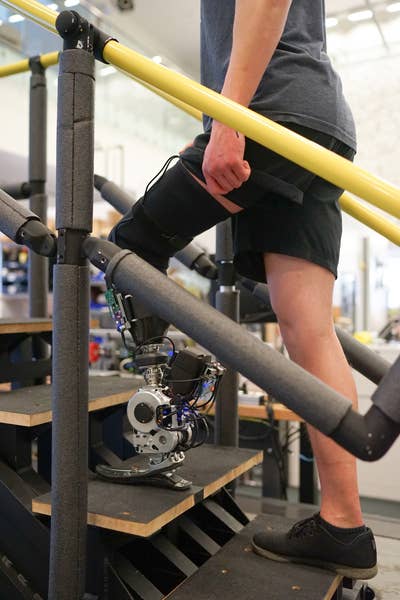The first brain-controlled bionic leg revolutionizes mobility for amputees
This is the first prosthetic study in history that shows a leg prosthesis under full neural modulation, where a biomimetic gait emerges.

This is the first prosthetic study in history that shows a leg prosthesis under full neural modulation, where a biomimetic gait emerges. (CREDIT: Courtesy of Hugh Herr and Hyungeun Song)
In a groundbreaking medical trial, a brain-controlled bionic leg has significantly improved mobility for people with amputations, enabling them to walk faster and navigate stairs and obstacles with greater ease. This innovative device allows wearers to control the movements of their prosthetic foot using only their thoughts, resulting in a more natural gait, better stability on uneven terrain, and a 41% increase in walking speed compared to traditional prosthetics.
The bionic leg operates by detecting activity in the user's remaining leg muscles and translating these signals to control an electrically powered ankle. This advanced technology allows for precise foot movements such as flexing, pointing, and rotating, all directed by the wearer's brain.
“No one has been able to show this level of brain control that produces a natural gait, where the human’s nervous system is controlling the movement, not a robotic control algorithm,” said Professor Hugh Herr, co-director of the K. Lisa Yang Center for Bionics at the Massachusetts Institute of Technology (MIT) and the senior author of the study.
Herr emphasized the transformative potential of this technology, saying, “Not only will they be able to walk on a flat surface, but they’ll be able to go hiking or dancing because they’ll have full control over their movement.”
Herr, who is a double amputee himself, lost both his legs to severe frostbite after being caught in a blizzard during a rock climbing trip in 1982. Despite the decades since his original amputations, Herr hopes to undergo revision surgery to benefit from similar bionic legs in the future. “I’m thinking of doing that for both of my legs in the coming years,” he said.
The Pioneering Trial and Its Findings
The trial, published in the journal Nature Medicine, involved seven patients using the bionic leg compared with seven patients using traditional prosthetics. Participants reported less pain and reduced muscle atrophy following the surgery necessary for the bionic leg. This surgery preserves natural connections between leg muscles, making the prosthetic limb feel more like a part of their body.
“[With] a prosthesis not controlled by the brain, patients view it as a tool, like a carpenter would view their hammer,” explained Herr. “When the person can directly control and feel the movement of the prosthesis it becomes truly part of the person’s anatomy. That can be quite emotional for the subjects that undergo this procedure.”
The Innovative Surgery Behind the Bionic Leg
The device requires patients to undergo a specialized form of below-the-knee amputation surgery known as agonist-antagonist myoneural interface (AMI). This surgery aims to preserve two pairs of muscle connections that are typically severed during conventional amputations. In a healthy leg, these muscles are responsible for flexing, pointing, and tilting the foot side to side.
During AMI surgery, the remaining muscles are reconnected, allowing the patient’s muscle contractions to be monitored and translated into movements of the prosthetic's electrically powered ankle. This procedure can be performed during the initial amputation or as a revision surgery after a traditional amputation.
Dr. Sigrid Dupan, an expert in prosthetics at University College Dublin who was not involved in the study, highlighted the significance of this advancement. “The study shows impressive results for the walking speed, but I think the results related to how people are able to cope with differences in terrain will have a more profound impact on people’s lives,” she said. “I’m looking forward to seeing how this research develops, and would love to see a broader implementation of this surgical approach.”
Future Prospects and Wider Implications
The research team at MIT is optimistic about the future of this technology. They hope to make a commercial version of the bionic leg available within five years, potentially benefiting many more patients. “It’s going to lead to a step-change in clinical care for so many patients around the world,” said Herr. “We’re very passionate about getting this technology out to the patients who need it.”
The successful trial of this brain-controlled bionic leg represents a significant leap forward in prosthetic technology. It offers a new level of mobility and integration for amputees, enhancing their ability to navigate various terrains and engage in diverse activities. This innovation not only promises to improve the quality of life for individuals with amputations but also paves the way for future advancements in the field of bionics and prosthetics.
By harnessing the power of the brain and preserving natural muscle connections, this technology marks a pivotal shift from purely mechanical prosthetics to devices that work in harmony with the human body's inherent capabilities. The emotional impact on patients who experience their prosthetic limbs as true extensions of themselves underscores the profound potential of this groundbreaking development.
As research and development continue, the hope is that such technologies will become widely accessible, offering improved mobility and independence to countless individuals around the world.
Note: Materials provided above by the The Brighter Side of News. Content may be edited for style and length.
Like these kind of feel good stories? Get the Brighter Side of News' newsletter.



